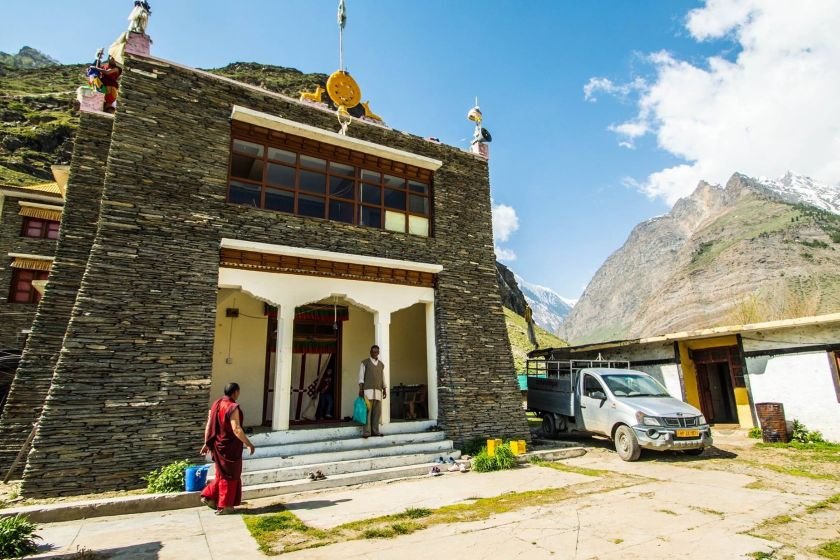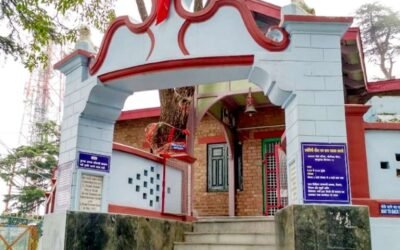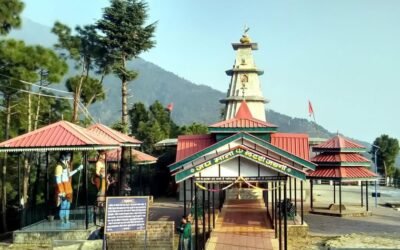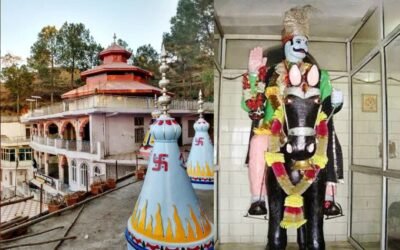Perched high above the confluence of the Chandra and Bhaga rivers near Tandi, the Guru Ghantal Monastery—also known as Gandhola Gompa—is believed to be the oldest Buddhist monastery in Lahaul, dating back to the 10th or even 8th century CE. With its wooden idols, white marble relics, and windswept solitude, this gompa is a spiritual relic of Himalayan antiquity, echoing with legends of Padmasambhava, Rinchen Zangpo, and Guru Ghantapa.
🌄 Location & Accessibility
- Location: Hill above Tupchiling village, near Tandi Bridge, Lahaul, Himachal Pradesh
- Altitude: ~3,000 meters above sea level
- Nearest Town: Keylong (9 km), Tandi (2 km)
- How to Reach:
- By Road: Manali → Atal Tunnel → Tandi → Tupchiling → Trek to Guru Ghantal
- Trek: 3–4 hour uphill hike from Tupchiling Monastery
- By Rail: Nearest station – Joginder Nagar or Pathankot
- By Air: Bhuntar Airport (Kullu) or Gaggal Airport (Kangra)
🛕 Historical & Spiritual Significance
There are multiple origin legends surrounding the monastery:
- Some believe it was founded by Guru Padmasambhava himself in the 8th century CE
- Others attribute it to Rinchen Zangpo, the great translator and builder of Himalayan gompas
- A third tradition links it to Guru Ghantapa, a tantric yogi and local saint
The monastery was once sacred to both Hindus and Buddhists, and its black stone idol of Kali (Vajreshwari Devi) and white marble head of Avalokiteshvara reflect this syncretic heritage.
🕉️ Deity & Worship
Guru Ghantal Monastery is dedicated to Guru Padmasambhava (Guru Rinpoche), the tantric master who introduced Vajrayana Buddhism to the Himalayas. The monastery also houses sacred representations of Avalokiteshvara (Chenrezig)—the Bodhisattva of Compassion—and Brijeshwari Devi, reflecting the region’s syncretic spiritual heritage.
Worship here follows Drukpa Kagyu traditions, with monks and nuns performing daily chants, butter lamp offerings, and meditation rituals. The sanctum contains wooden idols of Guru Rinpoche and other lamas, along with a black stone image of Goddess Kali and a white marble head of Avalokiteshvara, believed to have been installed by Rinchen Zangpo. Though the monastery is partially in ruins, it remains a pilgrimage site for tantric practitioners, especially during the now-rare Ghantal Festival, once celebrated with masked dances and communal feasts.
🏛️ Architectural Highlights
- Built in Indian-style stone and wood, unlike the clay-based gompas of Spiti
- Houses wooden idols of Padmasambhava, Brijeshwari Devi, and other lamas
- Contains ancient murals, stone-colored wall paintings, and a black stone Kali idol
- A white marble Avalokiteshvara head, now kept under lock and key due to theft concerns
- The gompa is weather-worn and partially crumbling, adding to its haunting beauty
🎉 Rituals & Lost Festivals
- Ghantal Festival (mid-June):
- Once celebrated on the 15th lunar day, with feasting by lamas and Thakurs
- Now discontinued, though the memory lingers in local oral traditions
- Caretaker Monastery: Most relics and rituals have shifted to Tupchiling Gompa, a branch monastery below
🏞️ Nearby Attractions
- Tupchiling Monastery: A small gompa at the base, often used as a staging point
- Tandi Sangam: The sacred confluence of Chandra and Bhaga rivers
- Kardang & Shashur Monasteries: Major Drukpa gompas across the valley
- Keylong: The district HQ with access to Lahaul’s cultural and trekking circuits
🙏 Spiritual Experience
The Guru Ghantal Monastery is not just a ruin—it’s a whispering archive of Himalayan faith, where wooden idols gaze across centuries, and the wind carries the chants of forgotten festivals. As you climb the steep trail from Tupchiling, each step feels like a pilgrimage into the past, and each prayer echoes through stone, sky, and silence.




